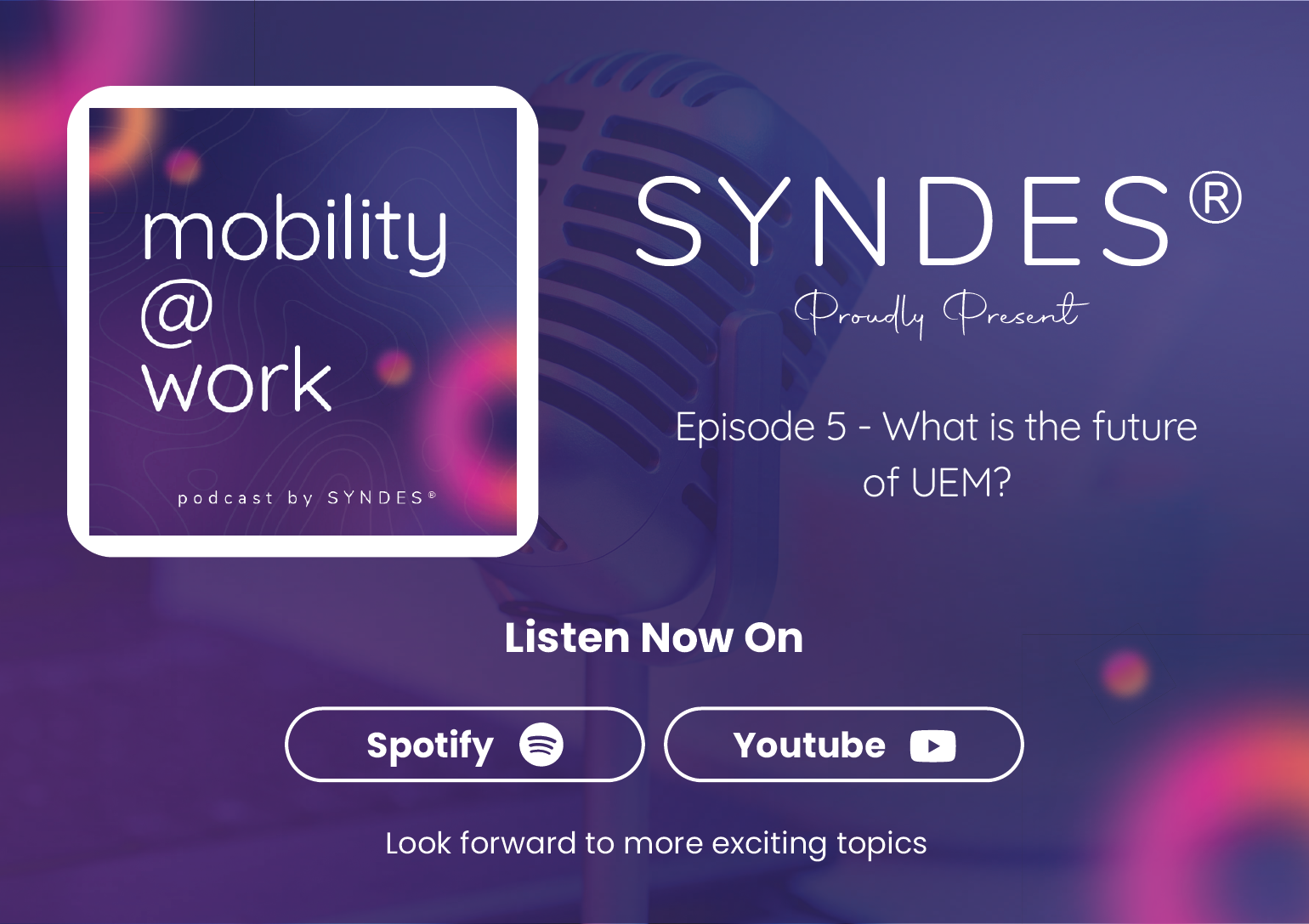
Episode 5: What is the Future of UEM?
[Intro Music: “Tech House vibes” by Alejandro Magaña (A. M.)]
TUN XIANG: Welcome to Mobility@Work and my name is Tun Xiang from SYNDES Technologies. We at SYNDES cover the must-have technologies for your business to keep you ahead of the curve.
[Intro Music: “Tech House vibes” by Alejandro Magaña (A. M.)]
podcast
TUN XIANG: With the Fourth Industrial Revolution knocking on the doors with digital devices in hand, applying unified endpoint management effectively is now more important than ever to stay ahead of the competition. We’ve covered the past and present of UEM over the past four episodes and joining us today for one last time is Amith from Mitsogo, who’ll cover the future of UEM from their point of view. So, Amith, what can you tell us about the future of UEM and what it hinges upon?
AMITH: Hello, everyone. I hope everyone’s doing well. Hmm, so, what is the future of UEM? I’d rather say UEM is the future for organisations. Security and privacy are a huge concern for users and enterprises. With the growth in working from home, endpoint security is becoming a major concern among enterprises embarking on a digital transformation journey. And the massive shift towards work from home has forced businesses to remodel their strategies and increase their spending on security, leading to increased demands for UEM as hybrid work has become a norm.
Apart from that, UEMs provide better security outcomes by reducing the complexity for IT to secure devices with a single console and the data protection and IoT growth boost demand for endpoint production in healthcare, finance, telecom, media and technology, and even government sectors. Moving forward, enterprises should expect a substantial increase in cyber-threats owing to automation, the IoT cloud growth and 5G as well.
TUN XIANG: Wow! So, you’re saying UEM doesn’t just have a future, UEM is the future. It’s always interesting to know what the future holds for current technologies, yeah? The pandemic has really given a direction for UEM to head towards in the future. I think addressing the problems of a hybrid or fully remote workplace that more and more organisations are transitioning to really ties into your goals of security and flexibility. The pandemic also led to the acceleration of digitisation and adoption of smart devices in the workplace together with existing emerging technologies that’s been in development beforehand.
Like you said throughout the podcast, more devices means more hassle and more potential for vulnerabilities, so there’s a place for MDM as long as that continues to happen in the future. So, let’s focus on the near future, speaking of which. I noticed you’ve mentioned about 5G towards the end of your response and it’s great to touch on that. As you know, 5G has just been rolled out in Malaysia at the end of 2021, and will be seeing widespread adoption in the coming years. Given that most new smart mobile devices are [laughs] ready for 5G, what impact will a 5G network have towards UEM?
AMITH: Well, 5G is already transforming and enhancing mobile connectivity. All businesses and industries are now in a position to digitise applications and services, thanks to 5G. As the rate of adoption increases, businesses will have to rethink and redesign their enterprise mobility strategies. However, enterprises should be aware of new security risks, which include the potential for increased attack surface. Basically, increased risk of privacy violations and faster data extractions, right? 5G will increase the adoption of smart devices,
wearables, AI, IoT, AR, VR, you name it. And with that happening, businesses will require UEMs to simplify device management and enterprises will need to adopt, to deploy security and management configurations to users and devices in real time.
TUN XIANG: Yeah, that’s for sure. I’ve seen 5G in action as soon as one of the local telco companies, Yes, became the first in Malaysia to release a 5G data plan. The download speed is mind-boggling. It’s one gigabit per second. I believe-
AMITH: Wow.
TUN XIANG: Yeah, that’s really fast. I believe that’s the speed of the fastest fibre network provider in Malaysia, TIME and like 5G achieving the same speed as fibre is definitely a game changer until the Wi-Fi standards catch up with it. So, that means smart devices can be lightning fast without the need for 5G networks and yes, faster opportunities for attacks like you mentioned. But yeah, not to mention the increased appeal. I guess that UEM will become a necessity for most organisations to cope with the 5G device boom. So-
AMITH: Yeah.
TUN XIANG: Other than 5G, so many new technologies have emerged in the 21st century that we’re said to be currently undergoing a Fourth Industrial Revolution. How much impact has the Fourth Industrial Revolution had on UEM so far and how will it continue to shape its future?
AMITH: Well, we are kind of on the cusp of the Fourth Industrial Revolution or Industry 4.0, bringing together digital technologies and data to create an interconnected autonomous system where our devices can collect and analyse data to make informed decisions. Well, today, workspace IoT is being used alongside mobile devices to increase productivity, efficiency and customer experience. Workspace IoT endpoints include wearables that include smartwatches, VR, AR headsets and smart glasses, peripherals including mobile printers, enterprise sleds and voice assistants, single-purpose devices including interactive kiosks and digital signages.
So, from an IT perspective, it’s no surprise that organisations see UEM as a key technology to control and manage this workspace IoT gear. UEM technology is ideal, yeah, for managing workspace IoT devices as many of the connected devices coming into the workplace are based on mobile-oriented operating systems. Apart from that, over the air software updates configuration management, provision for secure Wi-Fi and VPN connections make UEM the key to managing these sorts of all IoT devices.
TUN XIANG: The rise of IoT is really something not to be underestimated in industries from what I know. If you were to talk to me about this a decade ago, I would have never guessed all of those endpoints would become commonplace, you know. I mean, Siri only just came out in the iPhone 4S around that time (in 2011) and I only saw it as a novelty to have fun with. And some of those devices you mentioned, right, such as printers and digital signage used to be unconnected. Yeah, they used to work unconnected to the internet.
It’s really obvious that UEM has to accommodate IoT because some of the devices don’t really have an OS to begin with. You can’t just rely on the same programming of the UEM for say, a PC or smartphone. So, with more devices or things being able to connect to the Internet that’s not necessarily a smart smart device, there’s more devices to manage. And yeah, I can see that’s where UEM steps in and becomes a cornerstone of Industry 4.0 while evolving in the process.
Well, the future of UEM also goes hand-in-hand with the future of businesses. So, how does UEM aid in the digitisation of various industries? How does it improve how business processes are carried out?
AMITH: Well, in a constantly evolving enterprise technology environment, UEM plays a crucial role in securing your future. UEMs provide you with the tools to manage security across your endpoint ecosystem from a single console, right? So, when you control every device from a single console, admins can implement a universal set of processes to protect every person, every piece of data within your organisation. So, when you implement a particular security policy, for example, you apply this across every device, saving up the IT admin’s time and giving everyone the flexibility and convenience your work requires. Implementing a UEM in your business allows you to accurately track inventory usage and device-specific details from one single place.
TUN XIANG: Hmm, yeah.
AMITH: So, your technology becomes visible at the granular level, meaning you’ll create more opportunities to identify inefficiencies and optimise future processes. In many cases, this ability is different between success and failure going forward.
TUN XIANG: That’s good.
AMITH: Any organisation would definitely benefit by implementing UEM’s advanced security provisions. An organisation’s growth needs greater IT controls, more efficient workflows and streamlined user support. And UEMs are your best opportunity to create those.
TUN XIANG: So, it’s all about increasing your control, attention and efficiency with UEM. OK. So, one thing that happened to companies after UEM is that they don’t need to get someone to run around to update or perhaps install something to their work devices anymore. I expect IT departments to be downsized as a consequence. Also, instead of making educated guesses and crunching numbers at the end of the week or month, they can track quantifiable work statistics right away. You know, what a huge waste if a very capable UEM has all these things you can monitor but you don’t make use of them, right?
AMITH: Yeah.
TUN XIANG: Yeah. So far, we’ve talked about the future of UEM, but what about its users? How do you see UEM improving the lives of SME owners and ordinary people in the future? Why is this important?
AMITH: Definitely it will and it has improved the lives of SME owners. Apart from simplifying device management and improving IT security and everything we’ve covered so far, it’s the savings you make in the total cost of ownership. When done in a unified manner, UEMs are very economical, especially once you consider the infrastructure, licensing and management costs. These would be drastically less as opposed to say, different management tools for different devices, or worst case, no tools at all and manually managing all these devices. And from an employee perspective, yeah, and from an employee perspective, UEMs help them stay productive. I mean, why wouldn’t it?
UEMs enable employees to work on their preferred devices within the workplace. They’re able to work remotely knowing that an IT admin would be able to help them and troubleshoot the device in case of any challenges. And most importantly, it provides them a sense of security and control. IT admins can also silently push apps and software updates so the employees wouldn’t have to worry about anything and they can, you know, do what they want to do. That is, get their work done.
TUN XIANG: Oh yes, actually, yeah, the funds of an SME are usually very tight and SMEs are always looking for cost savings that don’t compromise too much on their productivity. I’m confident that once the UEM is up and running in an SME the cost of deploying and maintaining it should be cancelled out by the cost savings and increased efficiency of the workplace. As an employee myself, yes, I agree it’d be great if I don’t need to travel all the way to meet someone from the IT department when I’m not working in the office. And the IT department can be relieved by the fact that they don’t need to tell everyone to do this or that to update their devices when it can be automated as long as the devices have an Internet connection.
It’s been a really great conversation with you, Amith. We’ve learned so much you know from you about Hexnode and UEM in general over these five episodes. Before we wrap up, may I ask what Mitsogo’s future plans are for Hexnode that you’d like our listeners to know?
AMITH: Of course. So, Hexnode has been consistently upgrading and revamping in line with the developments in the domain to offer the best services to our customers. We are currently working on rolling out Hexnode Do, a SaaS management platform that provides a unified platform to manage and secure different SaaS applications. All of this while expanding the channel partnerships and collaborating with many technology solutions to provide an enhanced customer experience.
TUN XIANG: Sorry, could you explain to our listeners what SaaS is?
AMITH: SaaS applications are software as a service applications, so our applications, just like Hexnode, that you can access from anywhere if you have a working browser and Internet. So, you don’t have to have a specific OS or platform that you have to run this specific application. If you have a browser, if you have an Internet connection, you can just load up your mobile phone or any platform that you use and access your admin portals directly from your browser.
TUN XIANG: I see. So, thanks for the explanation about SaaS. I’m really glad to hear there’s something in the pipeline from Mitsogo, you know. The tech industry should always be innovating since nothing in the technology world has always been the same lately when you take a look back at its recent history. I can’t wait to try Hexnode Do out together with the Hexnode UEM when it’s released. I’m wishing the team behind Hexnode all the best in their future undertakings.
AMITH: Thank you so much and thanks for having me here again, and I wish SYNDES all the best for their future.
TUN XIANG: Great! I’m sold on the fact that UEM truly is the future and we better be ready to embrace it. Thank you so much, Amith, for being with us for the past five episodes explaining to everyone about MDM and UEM. That’s all for our five-part series with Mitsogo and thank you to our listeners for sticking with us all this time. Do check out our website syndes.biz and follow us on social media for more content about managing your business with technologies. I’m Tun Xiang and thank you for listening to Mobility@Work Stay tuned for the next episode. Goodbye for now!
[Outro Music: “Tech House vibes” by Alejandro Magaña (A. M.)]
Listen to our latest podcast on other platforms:
Spotify: https://loom.ly/WLaV8zE
Google: https://loom.ly/qZoCNBA
Apple: https://loom.ly/Sv2vmyU
Youtube: https://loom.ly/kUOh0ow
Sorry, the comment form is closed at this time.






